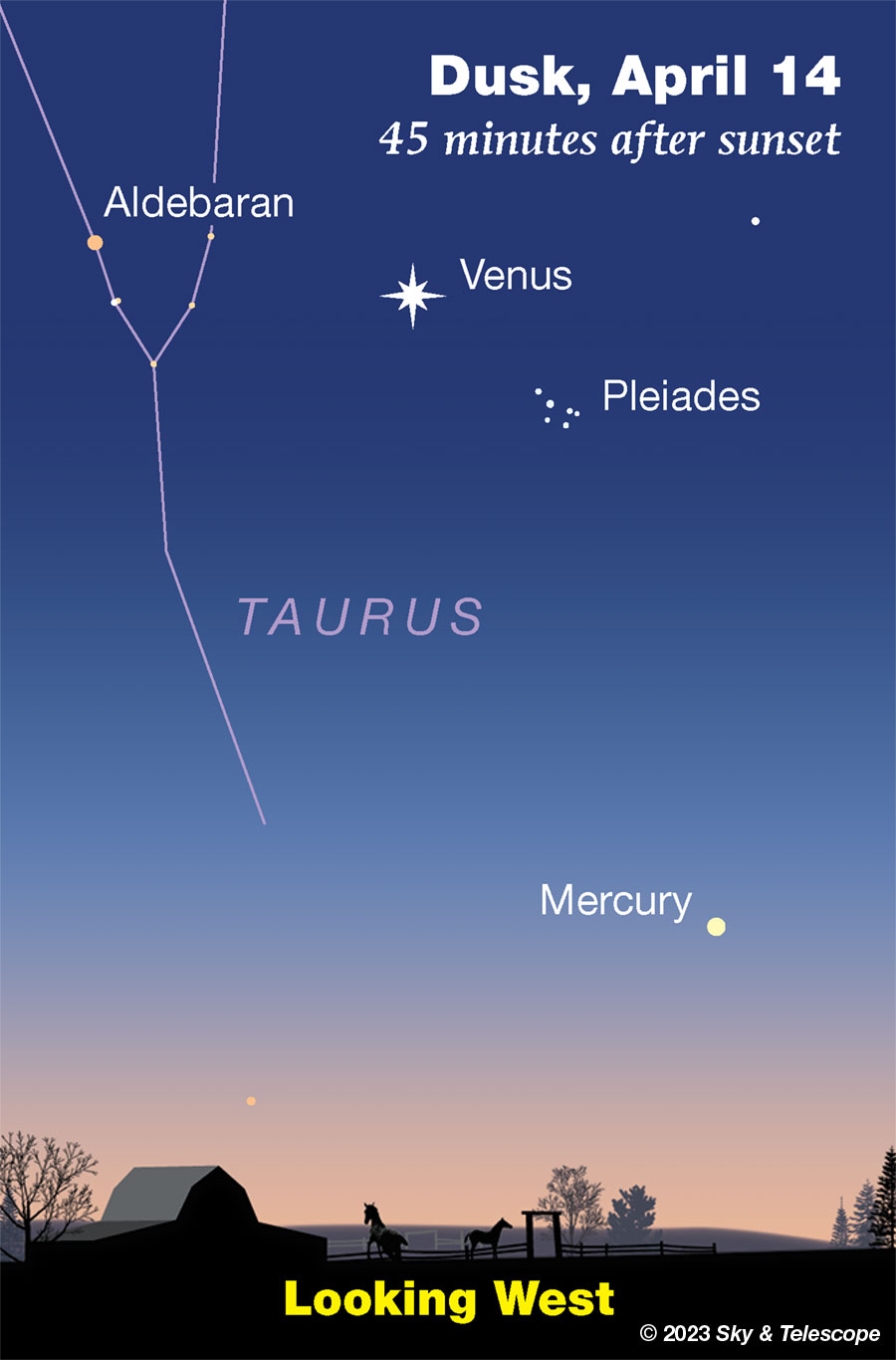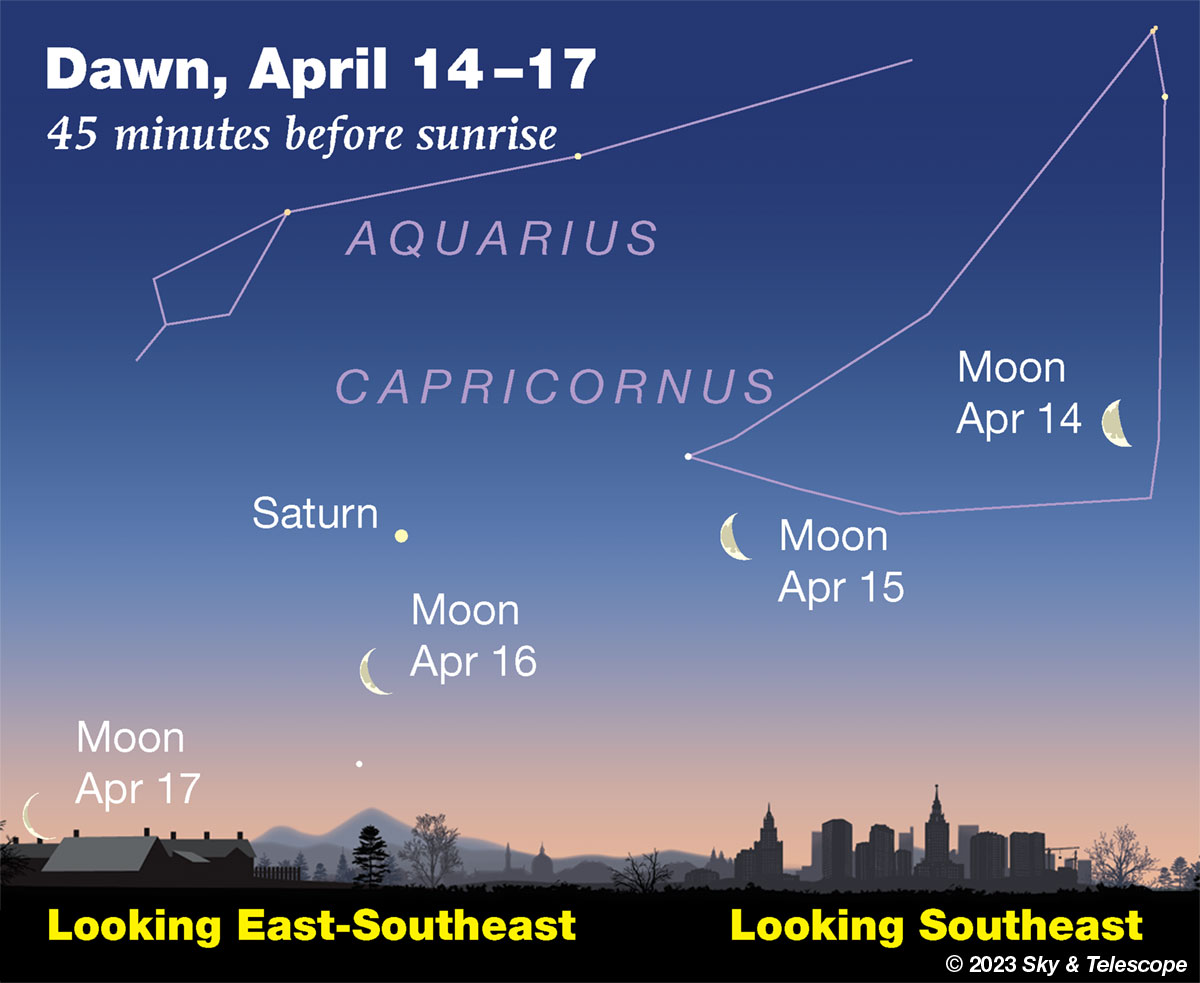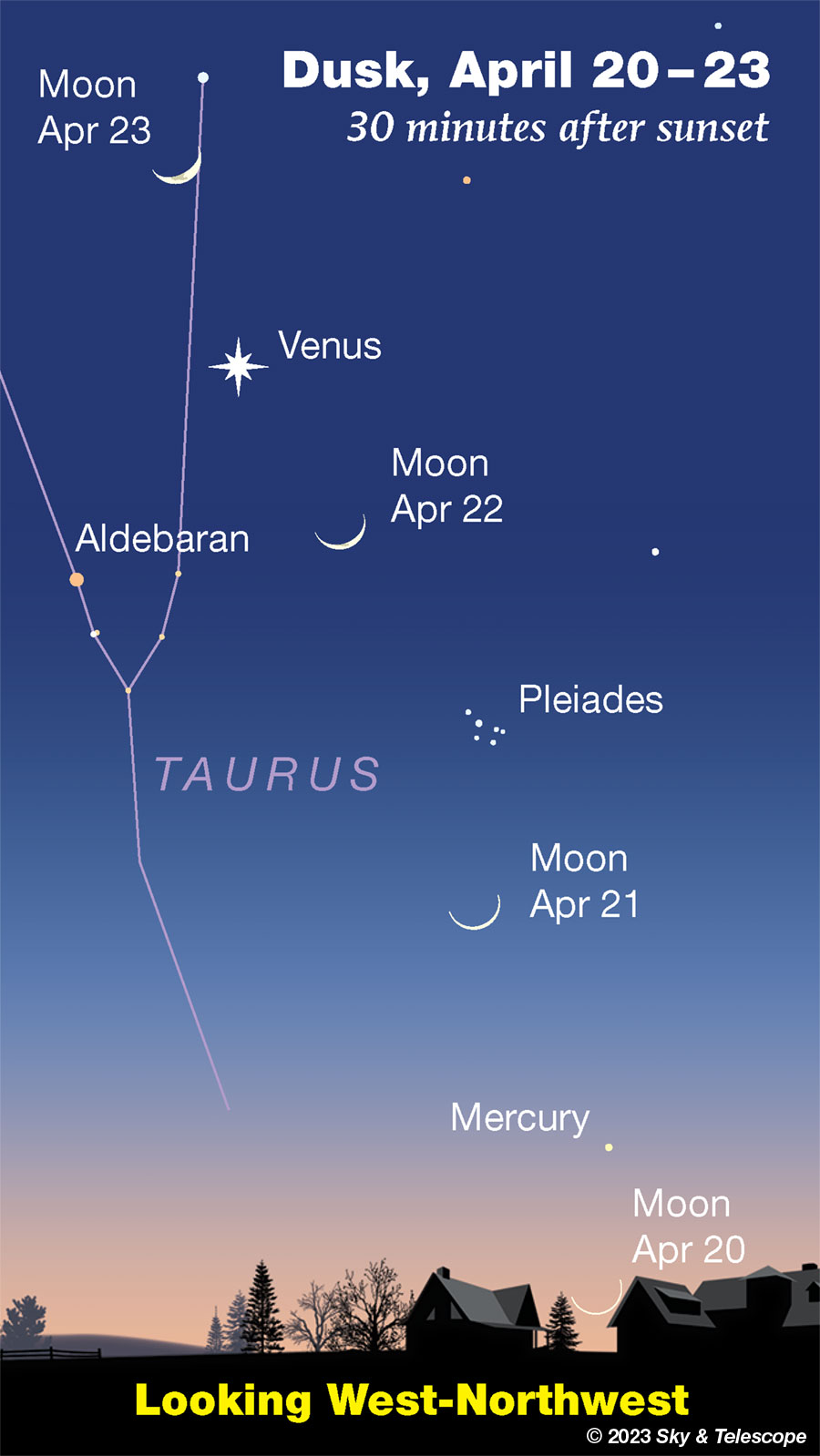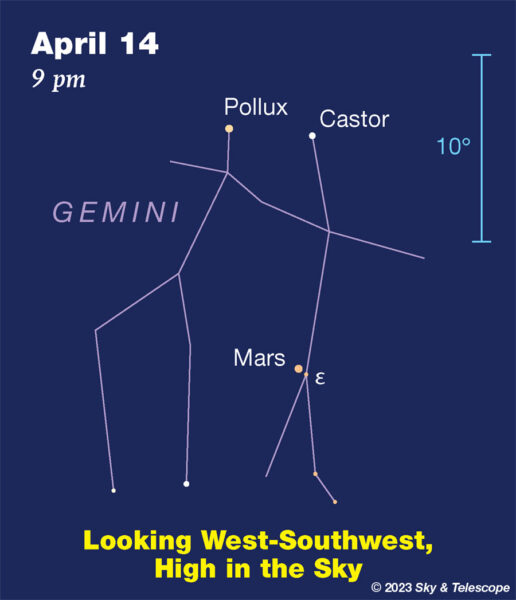FRIDAY, APRIL 14
■ Venus is still between Aldebaran and the Pleiades, as shown below. Watch the Pleiades sink farther down away from Venus day by day. This evening they're 5° apart. They'll widen by 1° per day, to 12° apart a week from now.

■ Meanwhile, Mars this evening shines just a small fraction of a degree from Epsilon Geminorum, one fifth as bright. Binoculars give a fine view. See "This Week's Planet Roundup" below.
SATURDAY, APRIL 15
■ In early dawn Sunday morning, spot the waning crescent Moon very low in the east-southeast. About 5° above it is distant Saturn, magnitude 1.0, beginning its nearly year-long apparition.

SUNDAY, APRIL 16
■ Right after dark, the Sickle of Leo stands vertical high in the south. Its bottom star is Regulus, Leo's brightest. Leo himself is walking horizontally westward. The Sickle forms his front leg, chest, mane, and part of his head. Off to the left, a long right triangle forms his hind end and long tail.
■ The Lion and the Mouse. A few degrees west of the top of Leo's Sickle are Kappa and Lambda Leonis, magnitudes 4.5 and 4.3, separated by 3½°. They form the nose and chin of the Lion's stick figure. Due south of Lambda (the chin) by ½° is the galaxy NGC 2903. It's 9th or 10th magnitude visually, making it Leo's second-brightest galaxy. In his April Binocular Highlight column, Matt Wedel admits that this is not a binocular object except for large binocs under a dark black sky. But my 6-inch reflector at 95x can reveal it even through suburban light pollution, as a faint gray wisp. It's elongated almost north-south. "There's nothing else nearby," Matt writes in the April Sky & Telescope, "giving the galaxy the lonely aspect of a mouse before the mighty celestial lion."
MONDAY, APRIL 17
■ After dark, look high in the west for Pollux and Castor lined up almost horizontally (depending on your latitude). Mars, looking similar, is a third dot below them.
Pollux and Castor form the top of the enormous Arch of Spring. To their lower left is Procyon, the left end of the Arch. Farther to their lower right is the other end, formed by Menkalinan (Beta Aurigae) and then brilliant Capella. Venus shines under its Arch's right side. The whole thing sinks in the west through the evening.
Modern skywatchers are not alone in seeing the Arch of Spring as one big asterism. Extend it down past Procyon to add Sirius, and you've got the Hawai‘ian Canoe-Bailer of Makali‘i. Looks big enough to bail the whole ocean.
TUESDAY, APRIL 18
■ Right after dark, Orion is getting ever lower in the southwest in his spring orientation: striding down toward the right with his belt horizontal. His belt points left toward Sirius and right toward Aldebaran and, farther on, Venus.
WEDNESDAY, APRIL 19
■ Arcturus shines brightly in the east these evenings. The Big Dipper, high in the northeast, points its curving handle down to the lower right toward it.
Arcturus forms the pointy end of a long, narrow kite asterism formed by the brightest stars of Boötes, the Cowherd. The kite is currently lying on its side to Arcturus's left. The head of the kite, at the far left, is bent slightly upward. The kite is 23° long, about two fist-widths at arm's length.
■ Now turn northwest. The brightest star there is Capella, Arcturus's near-equal. They stand at exactly the same height above your horizon around the very end of twilight, depending on your latitude.
■ New Moon (exactly so at 12:35 a.m. tonight Eastern Daylight Time).
THURSDAY, APRIL 20
■ Catch your record-young Moon? The Moon is less than a day old as seen shortly after sunset from North America. Starting about 15 minutes after sunset, use binoculars or a telescope to see if you can detect it just above the west-northwest horizon. If you do, can you then see any trace of it with the naked eye? For East Coast observers the Moon will be only 19 or 20 hours old; for the West Coast, 23 hours old. That's very nearly the youngest Moon that's theoretically possible to see. If you succeed note the time, and find the Moon's exact age since it was new 12:35 a.m. on this date Eastern Daylight Time.
If you manage to sweep up faint little Mercury, magnitude 2.0 now, look for the Moon-shred below it by 6°.
The short bit of a crescent, if you succeed, will be nowhere near as clear, long, and unbroken as in the March 20th illustration below. Long-lens photography (use a tripod) and some careful image processing may pull it out of the bright haze better that you eye can. It'll be oriented like a shallow cup. See the April Sky & Telescope, page 50. Good luck.
FRIDAY, APRIL 21
■ Look for the thin crescent Moon, much easier now, far lower right of Venus in twilight as shown below. As the sky gets darker watch for Aldebaran to appear, and then, much fainter, the Pleiades.

SATURDAY, APRIL 22
■ Venus, the crescent Moon, and Aldebaran form a nearly isosceles triangle in the west as darkness falls, as shown above. The long sides of the triangle are both 8° long (for much of the Americas).
SUNDAY, APRIL 23
■ Now the thickening Moon shines over Venus during and after dusk, as shown above.
This Week's Planet Roundup
Mercury is fading fast in the western twilight: from a modest magnitude +0.6 on Friday April 14th to an invisible (in the low twilight) +2.3 a week later. Early this week, use binoculars to help hunt for Mercury about two fists at arm's length to the lower right of Venus.
Venus (magnitude –4.1, in Taurus) is the brilliant "Evening Star" in the west during and after dusk. It doesn't set until two hours after full darkness. In a telescope Venus is a dazzling little gibbous globe (72% sunlit) 15 or 16 arcseconds in diameter. It's gradually enlarging and waning in phase. It'll be 50% lit by late May and a dramatic crescent from mid-June through mid-July.
Mars is crossing Gemini. Look for it high in the west in early evening, lower in the west later. It's upper left of Venus by three or four fists at arm's length, and below Pollux and Castor.
Mars has faded to magnitude +1.2, the same brightness as modest Pollux above it. But Mars shows a deeper orange tint.
Mars is nearly on the far side of its orbit from us, so in a telescope it's just a tiny blob 5½ arcseconds wide.

For the rest of April, Mars moves upper left from there.
Jupiter is out of sight in conjunction with the Sun.
Saturn, magnitude +1.0 in dim Aquarius, is emerging into early-dawn view low in the east-southeast. Binoculars help. The thin waning Moon hangs under it on the 16th.
Faint Uranus and Neptune are out of sight, very low in the evening and morning twilight respectively.
All descriptions that relate to your horizon — including the words up, down, right, and left — are written for the world's mid-northern latitudes. Descriptions and graphics that also depend on longitude (mainly Moon positions) are for North America.
Eastern Daylight Time (EDT) is Universal Time minus 4 hours. UT is sometimes called UTC, GMT, or Z time.
Want to become a better astronomer? Learn your way around the constellations. They're the key to locating everything fainter and deeper to hunt with binoculars or a telescope.
This is an outdoor nature hobby. For a more detailed constellation guide covering the whole evening sky, use the big monthly map in the center of each issue of Sky & Telescope, the essential magazine of astronomy.
Once you get a telescope, to put it to good use you'll need a much more detailed, large-scale sky atlas (set of charts). The basic standard is the Pocket Sky Atlas (in either the original or Jumbo Edition), which shows all stars to magnitude 7.6.

Next up is the larger and deeper Sky Atlas 2000.0, plotting stars to magnitude 8.5; nearly three times as many. The next up, once you know your way around, are the even larger Interstellarum atlas (stars to magnitude 9.5) or Uranometria 2000.0 (stars to magnitude 9.75). And be sure to read How to Use a Star Chart with a Telescope. It applies just as much to charts on your phone or tablet as to charts on paper.
You'll also want a good deep-sky guidebook. A beloved old classic is the three-volume Burnham's Celestial Handbook. An impressive more modern one is the big Night Sky Observer's Guide set (2+ volumes) by Kepple and Sanner.
Can a computerized telescope replace charts? Not for beginners, I don't think, and not on mounts and tripods that are less than top-quality mechanically. And as Terence Dickinson and Alan Dyer say in their Backyard Astronomer's Guide, "A full appreciation of the universe cannot come without developing the skills to find things in the sky and understanding how the sky works. This knowledge comes only by spending time under the stars with star maps in hand."
![]() Audio sky tour. Out under the evening sky with your
Audio sky tour. Out under the evening sky with your
earbuds in place, listen to Kelly Beatty's monthly
podcast tour of the heavens above. It's free.
"The dangers of not thinking clearly are much greater now than ever before. It's not that there's something new in our way of thinking, it's that credulous and confused thinking can be much more lethal in ways it was never before."
— Carl Sagan, 1996
"Facts are stubborn things."
— John Adams, 1770
 20
20









Comments
Rod
April 14, 2023 at 6:35 am
I did get out last night and enjoy some Venus views. Venus, M45, HIP18833, 37 Tau, 39 Tau, HIP19075 stars visible in eyepiece.
Observed 1930-2045 EDT. Sunset 1941 EDT, Last Quarter Moon 13-April-2023 0911 UT. I enjoyed Venus views tonight along with some stars near its position in Taurus, including the Pleiades or M45. Venus and HIP1833 close to 2.5 arcminute angular separation. Venus about 1.104 au distance, HIP18833 about 275 light-years. Very interesting to see the pair close together in the FOV. Venus was a distinct gibbous shape about 73% illuminated and 15 arcsecond size, very bright. Using the TeleVue 14-mm Delos eyepiece with my 90-mm refractor telescope, 71x views. Easy to see bright Venus as a planet with the star near its position. Stellarium 23.1 shows HIP18833 apparent magnitude 7.80. Other stars visible near Venus’s position were 37 Tau, 39 Tau, and HIP19075 in the FOV. 10x50 binoculars allowed a good view of M45, nearly 4 degrees from Venus tonight. 4 bats were flying around the fields tonight while I was out. Lovely sky and sunset with temperature 24C and SW winds 7 knots. Weed whacking and pasture mowing all the time now. 🙂
You must be logged in to post a comment.
mary beth
April 14, 2023 at 10:59 am
Very nice! We too saw Venus and a couple of bats…one very large one! Weather was perfect 70° during nautical twilight.
Our very own Anthony Barreiro got me interested in Polynesian navigation. Recently, I read up on some of the Hawaiian names for the stars. Sirius is Àà, meaning Burning Brightly, Aldebaran is Kapuahi, meaning Sacred Fire. Capella is Hôkü-lei, meaning Star Wreath. I decided to use these beautiful names this year when I refer to them. They’re perfect!
Thank you Anthony for your book referral!
During Astronomical Twilight we were happily surprised to see Arcturus: Hôkul’a, Star of Gladness and shortly after, Spica: Hikianalia, which simply means “star”. When these two are visible over the high Eastern treeline, it is a very personal seasonal marker for us, as it our wedding anniversary.
Happy Stargazing to all!
You must be logged in to post a comment.
Rod
April 14, 2023 at 1:50 pm
Excellent 🙂
You must be logged in to post a comment.
TomR
April 15, 2023 at 7:24 am
Congratulations to your wedding anniversary!
And happy stargazing! 🙂
You must be logged in to post a comment.
mary beth
April 15, 2023 at 11:40 am
Thank you so much! We do love to look at the stars!
You must be logged in to post a comment.
Anthony Barreiro
April 16, 2023 at 8:23 pm
Mary Beth, I join Hokul'a and Hikianalia in wishing you a happy anniversary and many happy returns!
You must be logged in to post a comment.
mary beth
April 16, 2023 at 9:40 pm
Thank you so much, Anthony! I was hoping you would get on here this week! Hope you are getting to see these beauties as well!
You must be logged in to post a comment.
misha17
April 19, 2023 at 10:33 pm
I just found a link for a livestream of the Eclipse from Northern Australia, featuring Pink Floyd's "Dark Side of the Moon".
Stream begins/began at 7:30pm EDT.
Album will end ("... the sun is eclipsed by the Moon") just at instant of totality.
https://www.youtube.com/watch?v=WJgHSju8Ybc
You must be logged in to post a comment.
misha17
April 14, 2023 at 3:11 pm
The Moon is I conjunction with Jupiter in April 19th. An occultation would be viewable from Mexico, Central America, northern South America and even the U.S. Atlantic Coast, but it occurs so close to the New Moon that both objects are close to the Sun (about 6 degrees away), so the event occurs during daytime or deep in the pre-dawn twilight just before sunrise.
You must be logged in to post a comment.
misha17
April 14, 2023 at 3:33 pm
The New Moon on the 20th features a hybrid central eclipse - annular at the beginning and end of its path in the southern Atlantic and Pacific Oceans, briefly total in the middle of its path over the islands north of Australia. This eclipse is part of Saros series 129. Six months ago it was preceded by a very deep partial eclipse from Saros series 124.
Because the Moon's orbit is not circular, usually when you have two central eclipses 6 months apart, one is annular (with the eclipse occurring near Lunar apogee), and the other one is total (with the Moon near perigee).
Occasionally you with have a hybrid eclipse in tandem with an annular eclipse (like this year), or in tandem with a total eclipse (as happened in 1930). However, 2 saros cycles ago, you had back-to- back ~hybrid~ eclipses.
You must be logged in to post a comment.
misha17
April 14, 2023 at 3:52 pm
Most of the central eclipses of Saros series 124 were total, but the last few were of short duration, partly because they were occurring near the North polar region 4000 miles further from the Moon than similar locations near the Equator, and partly because the eclipse were occurring further away from perigee, so the Moon's umbra was barely reaching the Earth's surface to begin with. The last central eclipse in October 1986 was only total along the middle of its short path near Greenland.
https://en.wikipedia.org/wiki/Solar_eclipse_of_October_3,_1986
The next eclipse in the series was only a deep partial eclipse.
Meanwhile, the central eclipses of Saros 129 had started out as annular, but as the series progressed the eclipses occurred closer to perigee, moving the umbra closer to the Earth's surface, while the central paths moved closer to the Equator, where the Earth's bulge brought the Earth's surface closer to the umbra. The eclipse of March 1987 was hybrid, as was the next in the series in April 2005. Next week's eclipse will be the last hybrid, then all the remaining central eclipses will be total as they occur closer and closer to perogee.
You must be logged in to post a comment.
misha17
April 14, 2023 at 7:26 pm
TimeAndDate will be streaming the hybrid eclipse on YouTube beginning at 9:30pm ET on Wedneday night April 19th. Link:
https://www.youtube.com/live/ifILl7GeZpE
You must be logged in to post a comment.
misha17
April 17, 2023 at 7:20 pm
The Gravity Discovery Centre and Observatory will also be streaming the event on YouTube - link:
https://www.youtube.com/watch?v=IWEv1DWel3Y
You must be logged in to post a comment.
mary beth
April 17, 2023 at 11:31 pm
Thank you! This gives me plenty of time to share it.
You must be logged in to post a comment.
misha17
April 19, 2023 at 5:27 pm
NASA TV will be streaming the eclipse beginning at 10:30pm EDT on Wedneday night (April 19th)
You must be logged in to post a comment.
misha17
April 19, 2023 at 5:29 pm
NASA TV link:
https://www.youtube.com/watch?v=21X5lGlDOfg
You must be logged in to post a comment.
mary beth
April 19, 2023 at 11:54 pm
Great links, thanks again. I switched back and forth between the three
You must be logged in to post a comment.
Rod
April 18, 2023 at 11:57 pm
I did get out tonight and enjoy some spring sky observing. Observed 1945-2300 EDT. Sunset 1946 EDT. New Moon 20-April-2023 0413UT. I viewed 10 targets tonight. Galaxies NGC 2903, M64, M66, NGC 3628, M95, M96, M86, M84, M51 and M3 globular cluster. More faint galaxies visible in Virgo tonight too, there are too many of them . NGC 2903 is featured in the April issue of Sky & Telescope, Binocular Highlight by Mathew Wedel, page 43. Very good view using the 10-inch at 34x. I used my 90-mm refractor at 25x too. Low power observing while sweeping the sky at times. Virgo cluster so many faint targets visible, M84 and M86 stood out sharply. M3 globular cluster a good view even at 34x using the 10-inch with TeleVue 35-mm PO eyepiece. I used TeleVue 40-mm plossl for 25x with my 90-mm refractor telescope. Shortly after sunset I warmed up by viewing Venus and Sirius. Bats were out flying around, later three or four owls started hooting and a fox was hunting. Lovely spring evening with temperature 8C and dropping, winds NE 7 knots. I did observe several polar orbiting satellites pass by while out, one passed close to M3 while I viewed, some others passed by in Leo. In the 10-inch, the satellites can be quite bright in the FOV.
You must be logged in to post a comment.
mary beth
April 19, 2023 at 1:44 am
Very nice report Rod. Still quite chilly there. Glad you had such a nice conditions. Are you planning on trying to catch any of the meteor shower?
Tonight is the 248th anniversary of Paul Revere’s Midnight Ride. I was wondering where the light from the two lanterns in the steeple would be in outer space now!
You must be logged in to post a comment.
Rod
April 19, 2023 at 1:31 pm
Lyrids for 22-23 April, likely no. Forecast is clouds and some rain coming my way, so I cut the pastures today and yesterday, plenty of weed whacking all around. Splitting more logs too 🙂
You must be logged in to post a comment.
You must be logged in to post a comment.